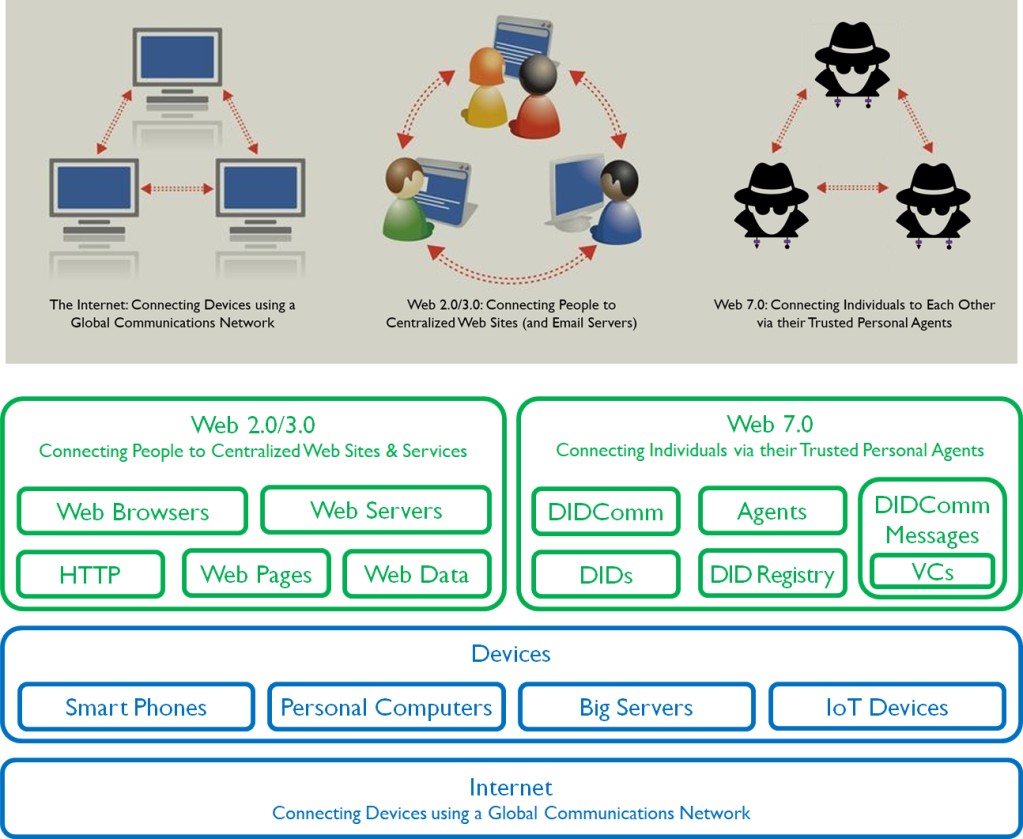A Design Guide for Software Architects and Developers working on DIDComm Agent-based Software Systems
Copyright (c) 2022 Michael Herman (Alberta, Canada) – Creative Commons Attribution-ShareAlike 4.0 International Public License
https://creativecommons.org/licenses/by-sa/4.0/legalcode
Web 7.0 is a unified software and hardware ecosystem for building resilient, trusted, decentralized systems using decentralized identifiers, DIDComm agents, and verifiable credentials.
Take what you need; leave the rest.
Michael Herman, Trusted Digital Web Project, Hyperonomy Digital Identity Lab, Parallelspace Corporation. January 2023.
This is the second public release of the Web 7.0 DIDComm-ARM whitepaper.
For a quick introduction, checkout the article Welcome to Web 7.0!.
Your comments and feedback on the DIDComm-ARM, its layered models, and Web 7.0 (seventh layer in the DIDComm-ARM) will be greatly appreciated.
You can find us on Twitter @ https://twitter.com/web7arch (hashtag #web7).
Download
- Welcome to Web 7.0! overview
- Web 7.0 DIDComm Agent Architecture Reference Model (DIDComm-ARM) whitepaper
Abstract

The purpose of this document is to introduce and describe the DIDComm Agent Architecture Reference Model (DIDComm-ARM) and the DIDComm Notation. The latter is a graphical modeling language used to design and model DIDComm Agent-based software systems.
The goals for this document are three-fold:
- Better understanding of the active components of DIDComm Agent-based software systems and how these components rely on and interact with each other,
- Introduce a new graphical modeling language, DIDComm Notation, to aid architects and developers in visualizing new architectures and designs for DIDComm Agent-based software systems, and
- Describe a layered architecture reference model, DIDComm-ARM, to help guide the design and creation of the broadest range of DIDComm Agent-based software systems possible.
DIDComm Notation contains elements for modeling:
- Conventional REST/HTTP clients, agents, and services
- DID Addressable REST/HTTP clients, agents, and services
- DIDComm clients, agents, and services
- DIDComm agents that utilize Verifiable Credential message attachments
- DIDComm mesh networks
- DIDComm user agents
- Virtual web drives and keystores
Collectively, these categories of DIDComm Notation modeling elements (and their interrelationships) define the DIDComm Agent Architecture Reference Model (DIDComm-ARM). The DIDComm-ARM contains multiple layered architecture models:
- Layer 0 REST/HTTP Agent Model
- Layer 1 DID Addressable REST/HTTP Agent Model
- Layer 2 DIDComm Agent Model
- Layer 3 DIDComm Agent with Verifiable Credential Attachments Model
- Layer 4 DIDComm Agent Mesh Network Model
- Layer 5 DIDComm User Agent Model (Appendix A)
- Layer 6 Web 7.0 DIDComm Agent Architecture Model (Appendix B)
The intended audience for this whitepaper is a broad range of professionals interested in furthering their understanding of DIDComm for use in software apps, agents, and services. This includes software architects, application developers, and user experience (UX) specialists; as well as people involved in a broad range of standards efforts related to decentralized identity, Verifiable Credentials, and secure storage.
The primary audience is software architects and developers designing and creating DIDComm Agent-based software systems[1].
This document is an independent work product produced by the author(s) and is neither a W3C, DIF, Sovrin Foundation, nor a ToIP work product – unofficial, official, or otherwise.

Pingback: Web 7.0 DIDComm Agent Architecture Reference Model (DIDComm-ARM) 0.27 | Hyperonomy Digital Identity Lab - hyperonomy.com
Pingback: Welcome to Web 7.0! (overview) | Hyperonomy Digital Identity Lab - hyperonomy.com
Pingback: [OLD] Web 7.0 DIDComm Agent Architecture Reference Model (DIDComm-ARM) 0.25 | Hyperonomy Digital Identity Lab - hyperonomy.com